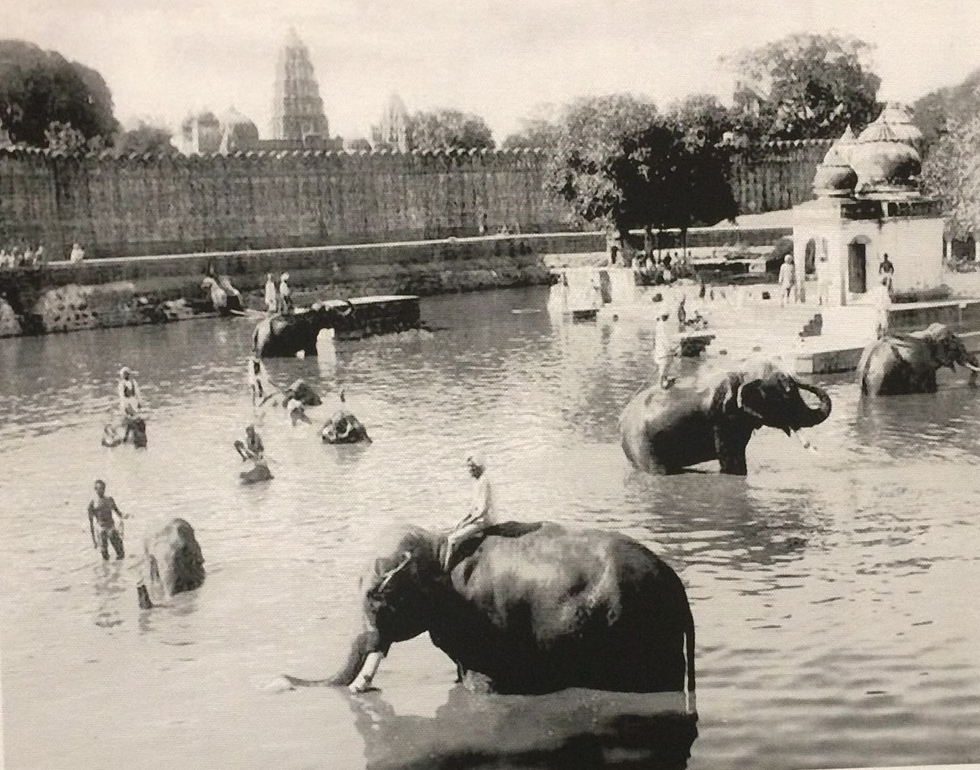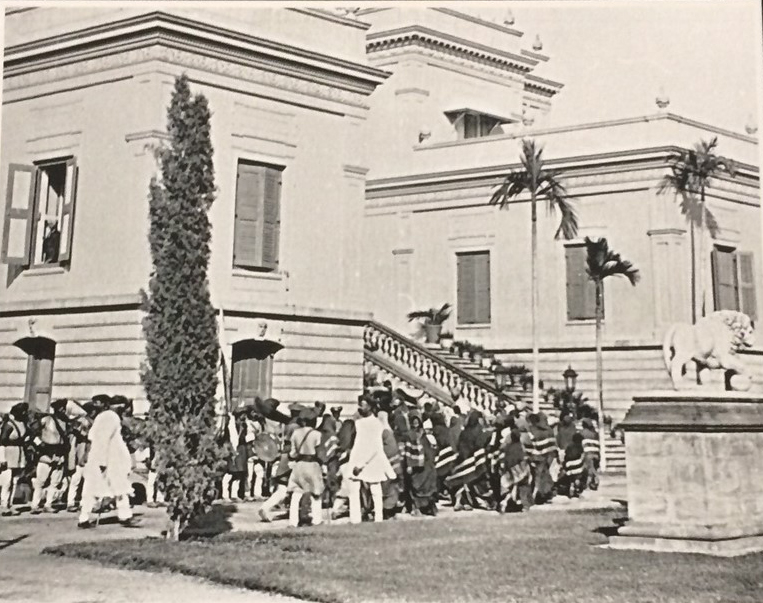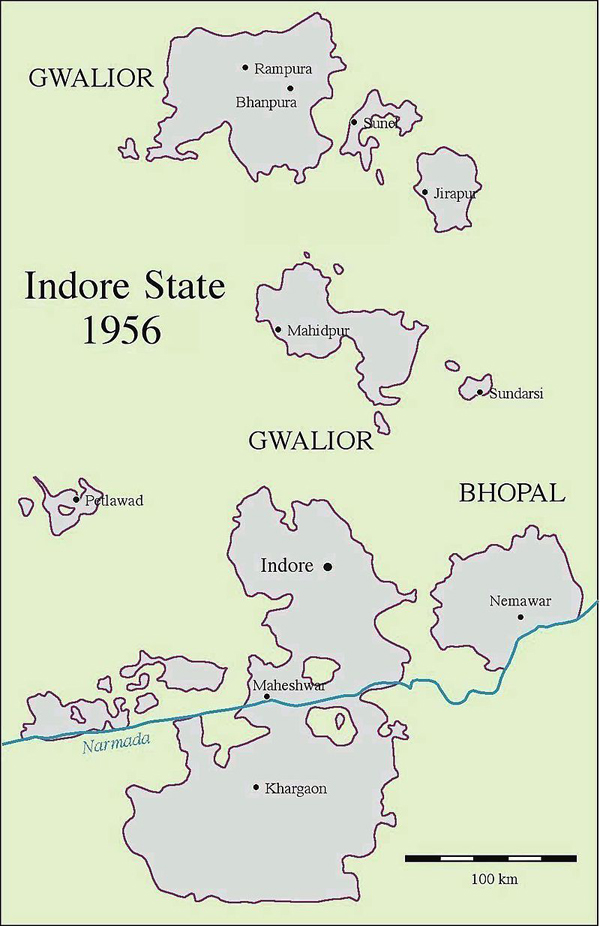The Holkar dynasty was a Hindu Maratha royal house in India. The Holkars ruled as Maratha Rajas, and later as Maharajas of Indore in Central India as an independent member of the Maratha Empire until 1818. Later, their kingdom became a princely state under the protectorate of British India..
By 1720, the headquarters of the local pargana were transferred from Kampel to Indore, due to the increasing commercial activity in the city. On 18 May 1724, the Nizam accepted the rights of the Maratha Peshwa Baji Rao I to collect chauth (taxes) from the area. In 1733, the Peshwa assumed the full control of Malwa. Malhar Rao, who joined the service of the Peshwas of the Maratha Empire in 1721, and appointed his commander Malhar Rao Holkar as the Subhedar (Governor) of the province.The name of the dynasty was associated with the title of the ruler, who was known informally as Holkar Maharaja.
On 29 July 1732, Bajirao Peshwa-I granted Holkar State by merging 28 and half parganas to Malhar Rao Holkar, the founder ruler of Holkar dynasty. The township of Indore had already existed as an independent principality established by Nandlal Mandloi of Kampel, Nandlal Mandloi was won by the Maratha force and allowed them to camp across the Khan (Kanh) River.
 Aerial view of Rajwada – 1950
Aerial view of Rajwada – 1950 Chhatribag-1900
Chhatribag-1900In 1734, Malhar Rao established a camp later called Malharganj. In 1747, he started the construction of his royal palace, the Rajwada. By the time of his death, he ruled much of Malwa, and was acknowledged as one of the five virtually independent rulers of the Maratha Confederacy.
He was succeeded by Ahilyabai Holkar (r. 1767–1795), his daughter-in-law. She was born in the Chaundi village in Maharashtra. She moved the capital to Maheshwar, south of Indore on the Narmada River. Rani Ahilyabai was a prolific builder and patron of Hindu temples in Maheshwar and Indore. She also built temples at sacred sites outside her kingdom, from Dwarka in Gujarat east to the Kashi Vishwanath Temple at Varanasi on the Ganges.
The adopted son of Malhar Rao Haolkar, Tukoji Rao Holkar (r. 1795-1797) briefly succeeded Rani Ahilyabai upon her death. Tukoji Rao had been a commander under Ahilyabai for her entire rule.
His son Yashwantrao Holkar (r. 1797–1811) (also called as Jaswant Rao) succeeded him upon his death. Attempts by Yashwantrao Holkar to unite the kings failed, and he was approached to sign a peace treaty with the British. The Treaty of Rajghat, signed late December 1805, recognised him as a sovereign king and returned all his territories, including Jaipur, Udaipur, Kota, Bundi, and some Rajput lands from other kings.
In 1811, the four-year-old Maharaja Malharrao Holkar II succeeded Yashwantrao Holkar. His mother, Maharani Tulsabai Holkar, looked after the administration. However, with the help of Pathans, Pindaris, and the British, Dharama Kunwar and Balaram Seth plotted to imprison Tulsabai and Malharraj When Tulsabai learnt about this, she beheaded both of them in 1815 and appointed Tantia Jog. As a result, Gaffur Khan Pindari secretly signed a treaty with the Britis to rule Indore as a princely state mainly owing to the efforts of their Dewan (Chief minister) Tatya Jog.
 Shiv Vilas Palace marriage scene – 1913
Shiv Vilas Palace marriage scene – 1913 Chhatribag- 1900
Chhatribag- 1900Malharrao Holkar III entered Indore on 2 November 1818. The capital was moved from Maheshwar to Indore on 3 November 1818.Tatia Jog was appointed his Diwan as he was a minor. As the old palace was destroyed by the army of Daulat Rao Scindia, a new palace was constructed in its place.
The treaty was signed on 6 January 1818 at Mandsaur. Bhimabai Holkar did not accept the treaty, and kept attacking the British by guerilla methods. Rani Lakshmibai of Jhanshi took inspiration from Bhimabai Holkar and also fought against the British. At the conclusion of the Third Anglo-Maratha War, the Holkars lost much of their territory to the British and were incorporated into the British Raj as a princely state of the Central India Agency. The capital was shifted from Bhanpura to Indore.
Malharrao III was succeeded by Martandrao Holkar, who formally ascended to the throne on 17 January 1834. But he was replaced by Harirao Holkar, nephew of Yashwantrao, who ascended to the throne on 17 April 1834. He adopted Khanderao Holkar on 2 July 1841 and died on 24 October 1843. Khanderao was formally installed as the ruler on 13 November 1843, but he suddenly died on 17 February 1844. Tukojirao Holkar II (1835–1886) was installed on the throne on 27 June 1844. During the period of Maharaja Tukoji Rao Holkar II (1852–86) efforts were made for the planned development and industrial development of Indore. During the reigns of Maharaja Shivaji Rao Holkar, Maharaja Tukoji Rao Holkar III and Maharaja Yeshwant Rao Holkar business in Indore flourished thanks to the railways that had been introduced in the state in 1875.
During the Indian Rebellion of 1857, he was loyal to the British East India Company. In October 1872, he appointed T. Madhava Rao as the Diwan of Indore. He died on 17 June 1886 and succeeded by his eldest son, Shivajirao.
Yashwantrao Holkar II (reigned 1926–1948) ruled Indore state until shortly after India’s independence in 1947, when he acceded to the Indian Government. Indore became a district of Madhya Bharat state, which was merged into Madhya Pradesh state in 1956.
After the independence of India in 1947, Indore State, along with a number of neighbouring princely states acceded to India. Yashwant Rao Holkar II, the last ruler of the state, signed the instrument of accession to the Indian Union on 1 January 1950. The territories of the state became part of the new Indian state of Madhya Bharat.
the Indore Residency, a political residency with a British resident was established in the city. Later Indore would be established as the headquarters of the British Central India Agency. In 1906 electric supply was started in the city, a fire brigade was established in 1909 and in 1918, the first master-plan of the city was drawn by noted architect and town planner Patrick Geddes.

1. Malhar Rao Holkar I (r. 2 November 1731 – 20 May 1766). Born 16 March 1693, died 20 May 1766
2. Male Rao Holkar (r. 23 August 1766 – 5 April 1767). Born 1745, died 5 April 1767
3. Ahilya Bai Holkar (first as a regent on 26 May 1766) (r. 27 March 1767 – 13 August 1795). Born 1725, died 13 August 1795
4. Tukoji Rao Holkar I (r. 13 August 1795 – 29 January 1797). Born 1723, died 15 August 1797
5. Kashi Rao Holkar (r. 29 January 1797 – January 1799) Born before 1776, died 1808
6. Khande Rao Holkar (r. January 1799 – 22 February 1807) Born in 1798, died 1807
7. Yashwant Rao Holkar I (first as a regent from 1799) (r. 1807 – 27 October 1811). Born 1776, died 27 October 1811
8. Malhar Rao Holkar II (r. 27 October 1811 – 27 October 1833) Born 1806, died 27 October 1833
9. Marthand Rao Holkar (r. 17 January 1833 – 2 February 1834). Born 1830, died 2 June 1849
10. Hari Rao Holkar (r. 17 April 1834 – 24 October 1843). Born 1795, died 24 October 1843
11. Khande Rao Holkar II (r. 13 November 1843 – 17 February 1844). Born 1828, died 17 March 1844
12. Tukoji Rao Holkar II (r. 27 June 1844 – 17 June 1886). Born 3 May 1835, died 17 June 1886
13. Shivaji Rao Holkar (r. 17 June 1886 – 31 January 1903). Born 11 November 1859, died 13 October 1908
14. Tukoji Rao Holkar III (r. 31 January 1903 – 26 February 1926). Born 26 November 1890, died 21 May 1978
15. Yashwant Rao Holkar II (r. 26 February 1926 – 1948). Born 6 September 1908, died 5 December 1961